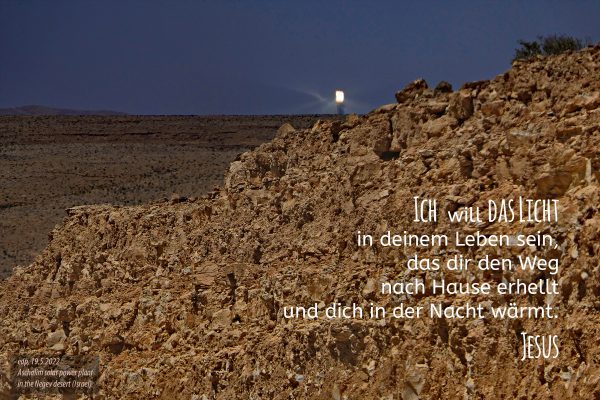
[nx_spacer]
Ich mag das Lied „Jesus meine Sonne, in der dunklen Nacht“ sehr. Er ist die Quelle meiner Freude, meiner Hoffnung, meiner Energie. Da passt der Vergleich mit einem Solarkraftwerk gut, das tausenden Menschen Strom, Licht und Wärme liefert. Nachdem ich am 19. Mai 2022 zum zweiten Mal den Tower des Solarkraftwerkes Ashalim in der Wüste Negev (Südisrael) aus der Entfernung sah, formulierte ich den Spruch auf dem Foto als eine Art Zusage oder Angebot von Jesus, der sagte: „Ich bin das Licht der Welt“ (Johannes 8,12):
Ich will das Licht in deinem Leben sein,
das dir den Weg nach Hause erhellt
und dich in der Nacht erwärmt. JESUS
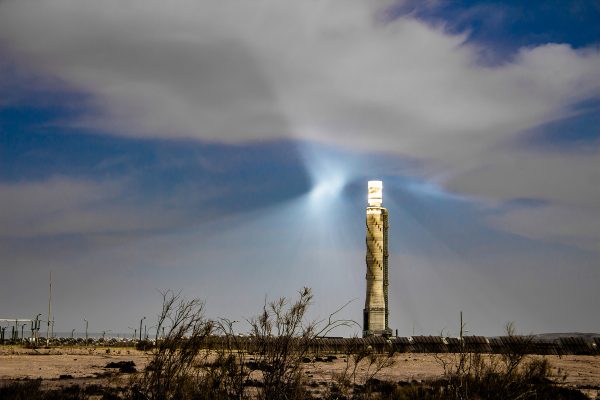
In der Wüste Negev. südlich von Beerscheba (im Süden Israels) arbeitet seit September 2019 das Solarthermischekraftwerk Aschalim als eines von drei Solar-Kraftwerken mit jeweils unterschiedlicher Technologie (Photovoltaik, Solarthermisch und Natural Gas). Auf einer Fläche von 390 Hektaren – rund 400 Fußballfeldern – lenken 454.832 Spiegel Sonnenwärme auf ein Netzwerk mit Öl gefüllter Rohre. Die ölige Flüssigkeit wird auf knapp 400°C erhitzt, und dann in Wasserdruck umgewandelt, der eine Turbine und die Stromproduktion antreibt.
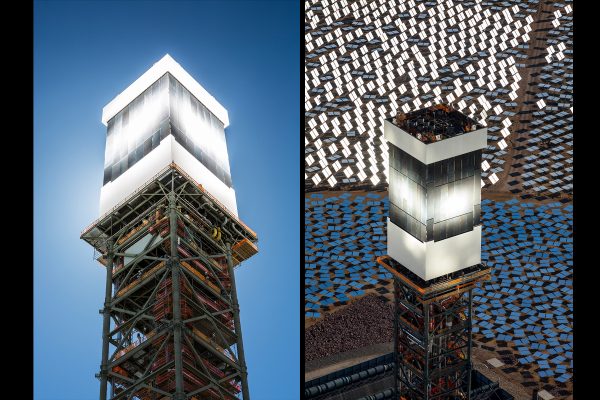
Beim neuen Kraftwerk steht in der Mitte der welthöchste Solarturm mit einer Höhe von 250 Meter. 50.600 bewegliche, computergesteuerte und per W-LAN verbundene Spiegel bündeln das Sonnenlicht, damit wird über mehrere Zwischenschritte das Wasser auf dem Turm erhitzt, das dann Dampfturbinen antreibt. Als einzige Anlage in Israel kann sie mittels eines Flüssigsalz-Wärmespeichers sogar nachts viereinhalb Stunden lang weiter Strom produzieren.
Mit einer Leistung von 300 Megawatt ist dies eines der größten solarthermischen Kraftwerke weltweit. Diese Kapazität reicht, um 130 Tausend Haushalte mit Strom zu versorgen, also etwa fünf Prozent der israelischen Bevölkerung. Bei voller Auslastung reduziere das Kraftwerk den Ausstoß von Kohlendioxid um 245.000 Tonnen. Das sei so, als nähme man 50.000 Autos von der Straße.
![]()
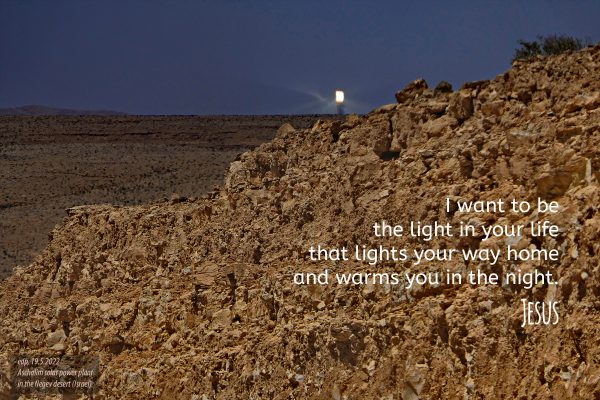
My solar power plant
I like the hymn “Jesus my sun, in the dark night” very much. He is the source of my joy, my hope, my energy. The comparison with a solar power plant, which provides electricity, light and warmth for thousands of people, fits well. After seeing the tower of the Ashalim solar power plant in the Negev desert (southern Israel) from a distance for the second time on 19 May 2022, I formulated the sentence on the photo as a kind of promise or offer from Jesus, who said: “I am the light of the world” (John 8:12):
I want to be the light in your life
that lights your way home
and warms you in the night. JESUS
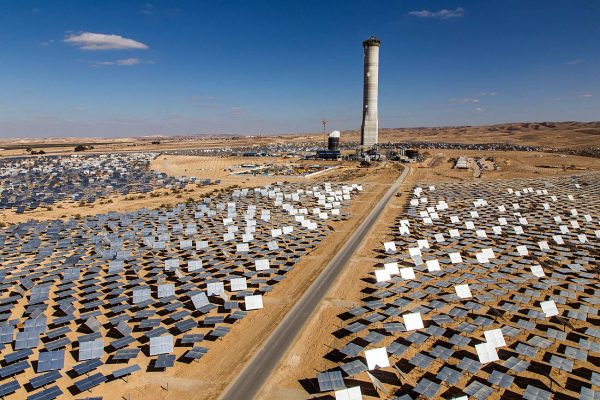
In the Negev desert. south of Beersheba (in southern Israel), the Ashalim solar thermal power plant has been operating since September 2019 as one of three solar power plants, each with different technology (photovoltaic, solar thermal and natural gas). Covering an area of 390 hectares – about 400 football fields – 454,832 mirrors direct solar heat onto a network of pipes filled with oil. The oily liquid is heated to nearly 400°C, then converted into water pressure that drives a turbine and electricity production.
At the centre of the new power plant is the world’s tallest solar tower, 250 metres high. 50,600 movable, computer-controlled mirrors connected via W-LAN focus the sunlight, which is used to heat the water on the tower in several intermediate steps, which then drives steam turbines. It is the only plant in Israel that can continue to produce electricity for four and a half hours at night by means of a liquid salt heat accumulator.
With an output of 300 megawatts, this is one of the largest solar thermal power plants in the world. This capacity is enough to supply 130 thousand households with electricity, or about five percent of the Israeli population. At full capacity, the power plant would reduce carbon dioxide emissions by 245,000 tonnes. That would be like taking 50,000 cars off the road.
![]()
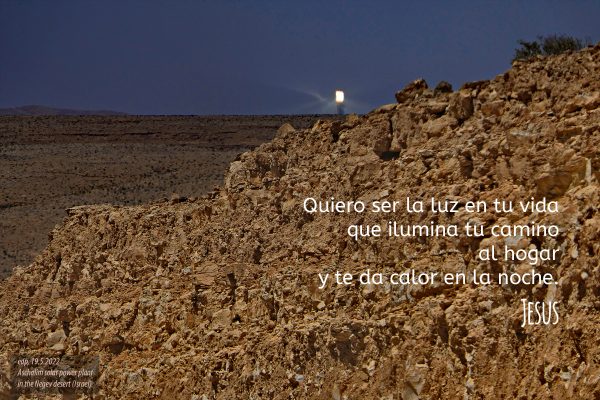
Mi planta de energía solar
Me gusta mucho el himno “Jesús mi sol, en oscura noche”. Él es la fuente de mi alegría, mi esperanza, mi energía. La comparación con una central solar, que proporciona electricidad, luz y calor a miles de personas, encaja bien. Después de ver por segunda vez desde la distancia la torre de la central solar de Ashalim, en el desierto del Néguev (sur de Israel), el 19 de mayo de 2022, formulé la cita en esta foto como una especie de promesa u oferta de Jesús, que dijo: “Yo soy la luz del mundo” (Juan 8:12):
Quiero ser la luz en tu vida
que ilumina tu camino al hogar
y te da calor en la noche. JESÚS
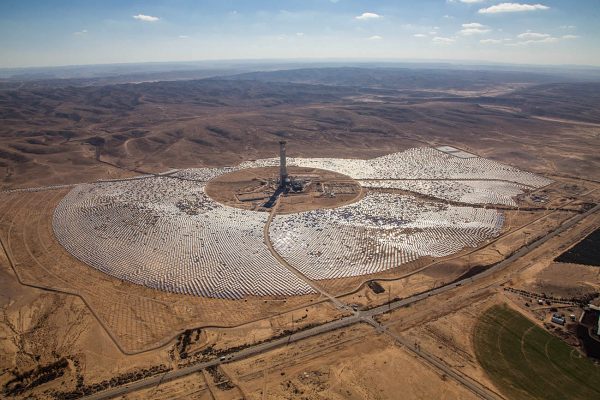
En el desierto del Néguev. al sur de Beersheba (en el sur de Israel), la central termosolar de Ashalim funciona desde septiembre de 2019 como una de las tres centrales solares, cada una con una tecnología diferente (fotovoltaica, termosolar y de gas natural). Con una superficie de 390 hectáreas -unos 400 campos de fútbol-, 454.832 espejos dirigen el calor solar hacia una red de tuberías llenas de aceite. El líquido aceitoso se calienta a casi 400°C y luego se convierte en agua a presión que impulsa una turbina y la producción de electricidad.
En el centro de la nueva central se encuentra la torre solar más alta del mundo, de 250 metros de altura. 50.600 espejos móviles, controlados por ordenador y conectados a través de WiFi, enfocan la luz solar, que se utiliza para calentar el agua de la torre en varios pasos intermedios, que luego impulsa las turbinas de vapor. Es la única central de Israel que puede seguir produciendo electricidad durante cuatro horas y media por la noche mediante un acumulador de calor de sal líquida.
Con una potencia de 300 megavatios, es una de las mayores centrales termosolares del mundo. Esta capacidad es suficiente para abastecer de electricidad a 130 mil hogares, es decir, aproximadamente el 5% de la población israelí. A pleno rendimiento, la central reduciría las emisiones de dióxido de carbono en 245.000 toneladas. Eso equivaldría a retirar 50.000 coches de la carretera.

